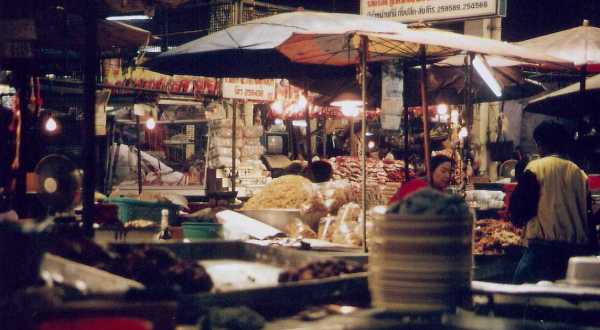
Nightmarket
In September 1993 we decided to travel to Thailand - our first trip to Asia. This is a detailed report explaining our experiences, troubles and mishaps, as well as some information which could be useful for travellers. Remark: information is marked with **/, but things may have changed meanwhile. This report descibes how we saw Thailand three years ago.
Just after our arrival at Bangkok Airport Don Muang we took the next train to Ayutthaya, approx. 70 km to the north of Bangkok.
**/ just in front of the airport there is a small
station, only 5-10 minutes on foot.
This is the best and cheapest way to travel further, both
to the north of Thailand and to the centre of Bangkok.
Don't be talked into taking expensive taxis!
Our room in the Cathay Hotel was quite simple and there were small geckos on the walls and under the ceiling. The roaring noise of the Tuk-Tuks could be heard from the street and a stifling heat was in the room.
 Nightmarket |
At night, when temperatures go down, the whole country awakes to new life. Numerous night markets are set up... Foreign impressions, strange smells and exotic spices... Several, partly undefinable dishes are prepared at small stands and mobile kitchens.
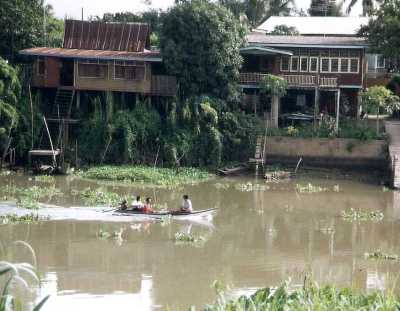 |
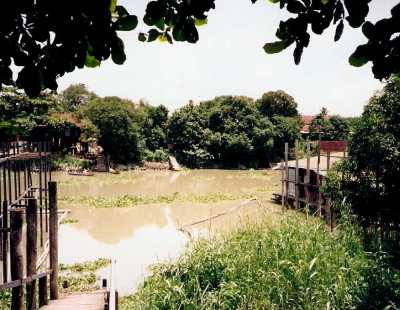 |
We felt almost magically attracted to a slight green coloured soup which was cooking in a large pot. Unknown vegetable and pieces of plants, as well as green-brown coloured, round and undefinable ingredients appeared, when the cook stirred up the soup. Inevitably we were reminded of one of those Indiana Jones films and first we hesitated, but then soon found out that those suspicious objects in question were nothing else, but eggs which were coloured by the dark shade of the soup.
During the day the air was filled with the stench of rubbish, strentghend by the heat. For unaccustomed, european noses quite strange, but one can get accustomed quickly.
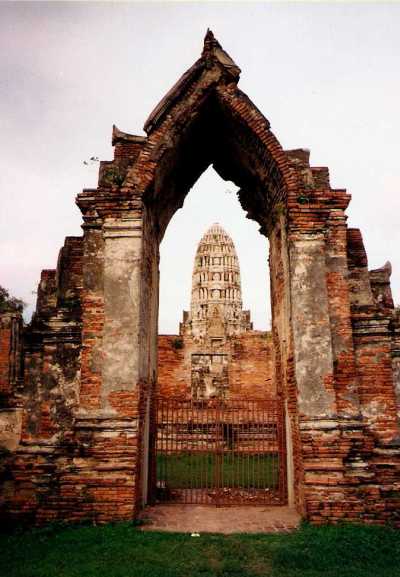
Wat Ratchaburana |
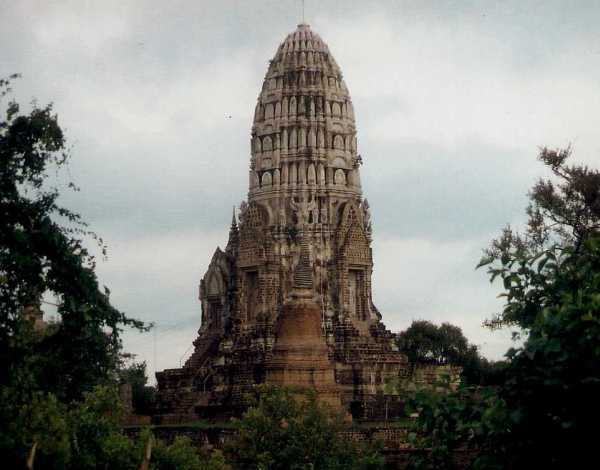
Prang von Wat Ratchaburana |

Buddhas im Wat Panon Choen |

Wat Jai Chai Mongkol |
Ayutthaya, which was founded in 1350 by king U-Thong and was plundered and destroyed in 1767 by the Burmese people, is surrounded by channels and rivers. Once Ayutthaya was the capital of one of the biggest Thai-kingdoms and evennow there are many historical temples in Ayutthaya and its surroundings which have survived.
**/ Our suggestion for good walkers:
most of the temples can be reached by foot. And
besides you can get a good impression of the town and
its nearby outskirts. The only temple which is far and
has to be visited by Tuk-Tuk is Bang Pa In. But arrange
the price for the Tuk-Tuk in advance! Those tours by
Tuk-Tuk which are offered almost everywhere are much too
expensive. The required prices don't meet at all with the
normal wage of a worker and our opinion is that these
propotions should not be disregarded.
A small ferry boat takes the people across the river in the south of the
town, for a few Baht only. Common people like these are also pleased to
gain from tourism, but not as much as some of the Tuk-Tuk drivers.
The hovels of the native people are close by the water. Longtail boats
force their way through the river which is partially covered by green,
creeping water plants.
Several times we were "interviewed" by Thai-pupils who wanted to practise
their knowledge of English.
These were our first days in Thailand, a strange, fascinating and beauti- ful world, far away from Europe.
The trains are often overcrowded - there are not enough seats and many
people have to wait in the corridor with their baggage - so did we...
We have noticed that these people are always very friendly and kind, also
to foreigners.
So the train is jolting along the tracks - with only 50 km/h crusing the
country. Of course it takes hours until the train has reached its
destination. But nobody has to starve: every few minutes dealers (often
children) are pushing through the crowded train, offering tins of Coca
Cola which are carried in a bucket, or fried chicken legs, or something
else.
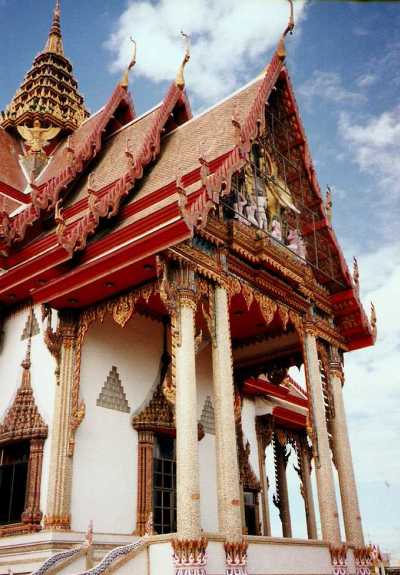 Der schönste Tempel bis dahin |
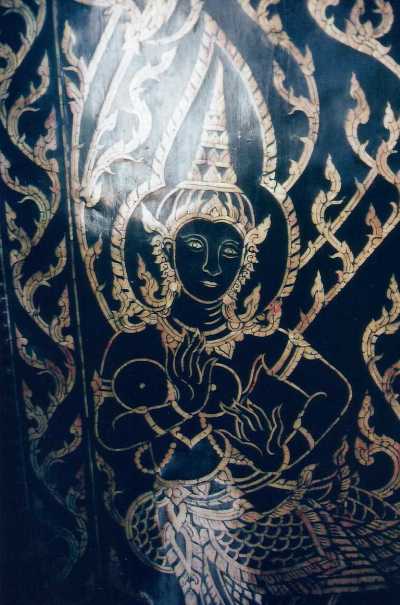 Türe aus Holz und Perlmut |
**/ The best way to go to Khorat (Nakon Ratschassima)
is by train again. A simple, but very clean accomodation
is the Fa Sang Hotel, about 300 m from the station.
You turn to the right, walk along the street and
you'll find the hotel on your left. If a Tuk-Tuk is
neccessary, a favourable price should be bargained.
In Khorat we were in the position to watch some monks working in the
street in front of their temple area. They had just painted the temple
and now gave us signs to view the temple area. And so we did...
A very beautiful temple, eastern-style, principally coloured white and
red. Ornaments covered with gold leaf, the columns and steps decorated
with mosaic work. Also the stairways were decorated with statues and the
portal was made of ebony with inlay of mother-of-pearl.
Phi Mai is an ancient Khmer settlement which was built in the 12 th
century and which was the twin town of Angkor in Cambodia. These towns
were connected by a paved street.
In the centre of the small town there is an ancient temple area which is
in a very good condition. It was constructed by king Daraindravarnam I.
Outside of the present town a part of the ancient city walls have
survived the centuries.
**/ Phi Mai is situated in the north-east of Khorat,
about 60 km away. It can be reached by public bus.
The temple area may be visited upon payment of a small
entrance fee, included is a visit to the local museum
which is outside of the town, but still within walking distance.
During the morning it had rained and when we arrived in Phi Mai the clouds
had just begun to disperse. The sun appeared and suddenly burning sunrays
began to tear the moisture from the bushes and out of the meadows.
The air was damp and thick, we could hardly breathe
We were impressed by the huge buildings which are stacked up with stone
blocks and partially decorated with reliefs. Lion statues are posed in
front of the entrance. The stony steps which lead to the separate temple
buildings are very high and slippery.
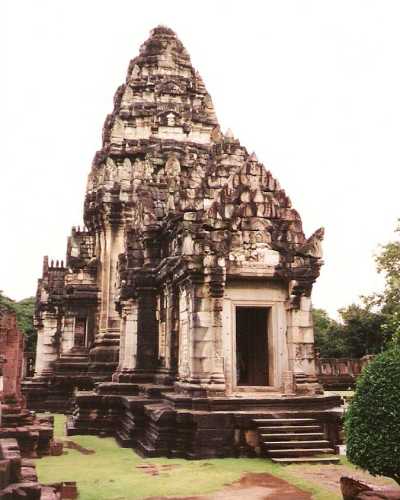
Phi Mai |
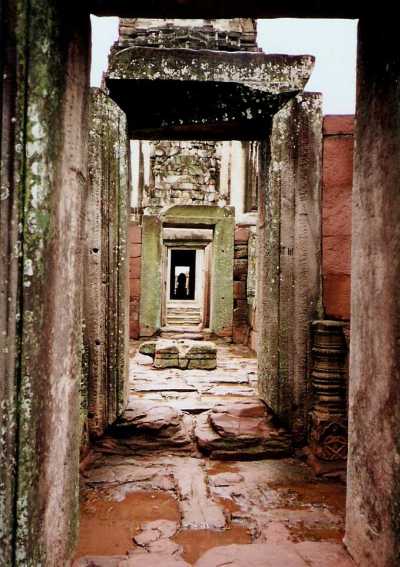
Phi Mai |
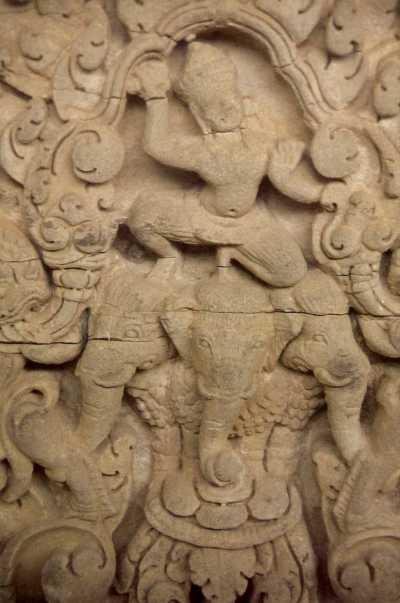
Relief |

Buddha |
**/ We found out that the railway traffic is not as
regular as in the centre of Thailand and so we
preferred to travel by bus. Your baggage, if possible,
should be kept within sight, objects of value, cheques,
passports in a small hand baggage. Although we have to
point out that we didn't have any bad experiences when
travelling by public means of transport, neither by
train, nor by bus.
Kon Khaen - rain, rain and (once) more rain...
The streets were flooded, our clothes had no chance to dry and the beds
were moistened by the high humidity of the air.
Over there, in Kon Khaen
we met no more Europeans, communication was difficult, because we
depended on our poor Thai-knowledge. In Kon Khaen there are a few beauti-
ful temples near the lake. Zebus and water buffalos are grazing almost in
the middle of the city.
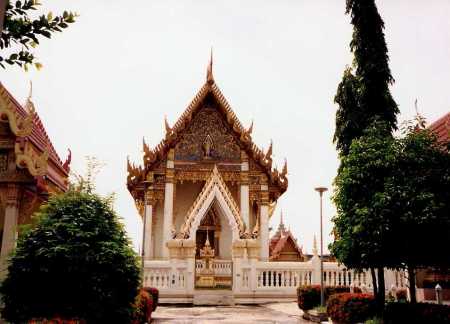 Temple lake side |
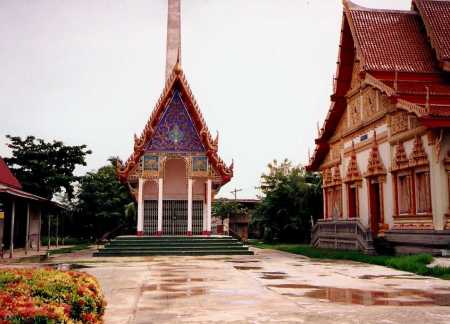 Temple lake side |
**/ A favourable accomodation is the Thanee Bungalow Hotel,
but it's very simple and one may not expect high standards.
However, the employed people are very kind and obliging.
We had worse experiences with Tuk-Tuk drivers who are
keen on catching a tourist and demanding "nice" prices.
(Indeed, we can afford paying more than resident people,
but within certain limits.
It should not be carried too far, 'cause most of the people
still have to work very hard for a few Baht.)
We also made the experience, that it's cheaper to take two
Rikschas and furthermore Rikscha driver are very friendly people.
Of course we have to mention our most famous insecticide - SKETOLINE - which rejects mosquitos, ants and all kind of insects. By the way it's very cool on the skin which is very pleasant in the heat - we used it as insect repellant and antiseptic, as well as a polishing agent for glasses, detergent etc...
**/ We travelled by bus again. By the way, we have always
preferred buses with fan, not only for the lower price.
You can get in touch with natives and you won't get
a cold as quickly as you may get in one of the cooled
Aircon-buses.
We are back on the touristic route. Sukhothai has many sights. We took two Rikschas at the bus station. The men knew a favourable accomodation - so they told us - and they brought us to a small Guesthouse, down in a quarter some yards away from the centre. Among chicken, pigs and water buffalos: The Friendhouse - the owner was Mr. Chang, an English teacher.
Each morning we ate a very filling Thai breakfast, Khao Tom Gai, a soup with rice, chicken and spices. And in the evening when the daily shower came down (sometimes these rainfalls can even last a few hours), we sat on a palm-roof covered terrace and talked and awaited the end of the rain. In Asia people don't hurry.
In this context our friend Victor has to be mentioned...
A Peruvian who had been away from home for 25 years, who had seen many
countries and had worked in several of them. Now he was living and working
in Thailand and he was very pleased as he heard us speaking spanish, 'cause
it was many years ago that he had had the opportunity to speak spanish. And
during these long and rainy evenings he told us stories of his peruvian home
country, about snakes and ghosts. And we also learned that Thai people have
a very strong belief in good and bad ghosts.
 Wat Chana Sonkhram |
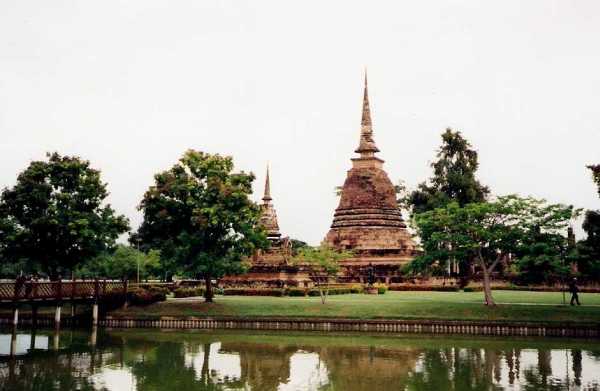 Wat Sra Sri |
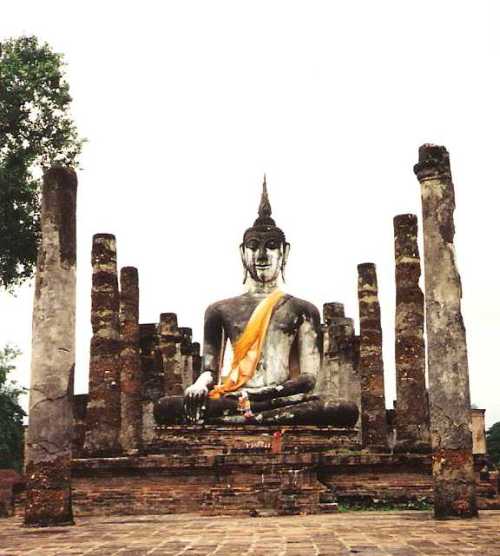 Der wichtigste Tempel hier: Wat Mahatat |
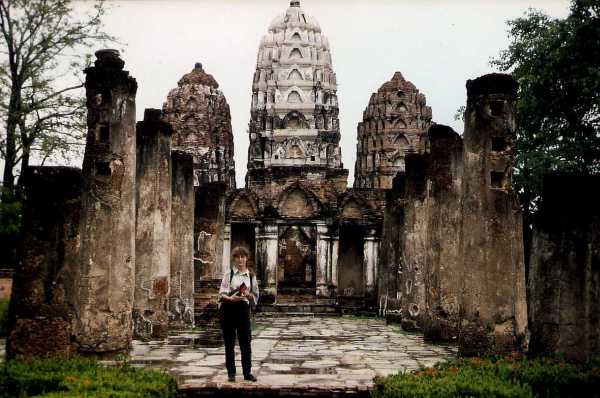 Lopburi stile temple |
Once we walked through one of these roofed, dark markets which are full of
nooks and corners. Between the tangle of the closely packed stands only
narrow passages were formed and crowds of people were looking at the
goods and bargaining. We came to a stand, set apart from the big crowd, where
fresh pork was offered.
Sides of pork and hind legs were stored on a big
table. A strange atmosphere lay in the air when we suddenly saw two human
feet between the stacked up porks in the twilight! Was it an optical
illusion??! This is one of the situations when sudddenly the heart begins
to beat and one doesn't dare to have a closer look...
But indeed, there was a man lying between the pigs - was he dead ??
Oh no, he had just moved - he seemed to be having a snooze only...
It is worthwile to have a look at one of those chinese pharmacies. Not
only for the spices, plants and miracle drugs they sell...
It is usual for them to sell drinks also. So you can drink your Coca Cola
or some juice at the pharmacie.
Old Sukhothai is not far away from the modern town centre. It consists of many historical temples and temple areas. The easiest way to get there is by Songthaew (minibuses or lorries with cargo area). The Sonthaew will drop you at the main street.
The foundations of Old Sukhothai were laid almost 700 years ago, when the Thai people who came from the north (today South China) chased away the Khmer and founded the kingdom Sukhothai which existed for approx. 200 years (13th - 15th century).
**/ It's possible to explore Old Sukhothai on foot, but
you can also rent a bike at the entrance.
Some of the temples can be visited in exchange for a free
donation, but for the most famous temples within the main
district an entrance fee has to be paid.
Another famous sight is Sri Satchanalai which can be reached by public bus
from the bus station in Sukhothai. It is recommandable to rent a bike in
Sri Satchanalai (there are several hirers along the street), to cover the
long distances between the temples and ruins.
A suspension bridge leads across the river Yom (Mae Nam Yom). For the most
important temples a small entrance fee has to be paid.

Suspension bridge over Mae Nam Yom river |

Mae Nam Yom river |
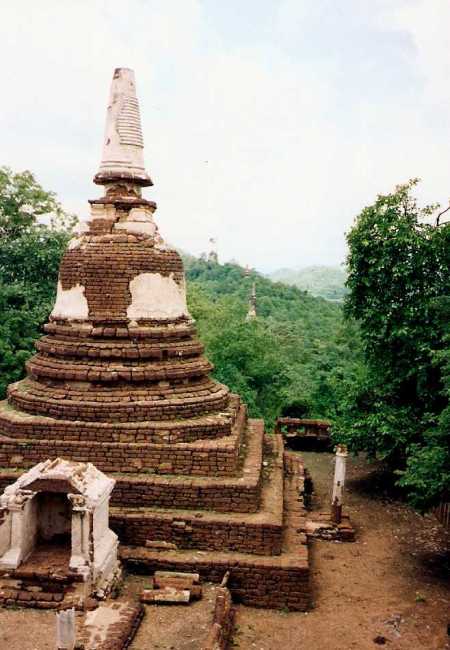
Wat Kao Phanom Phlerng |
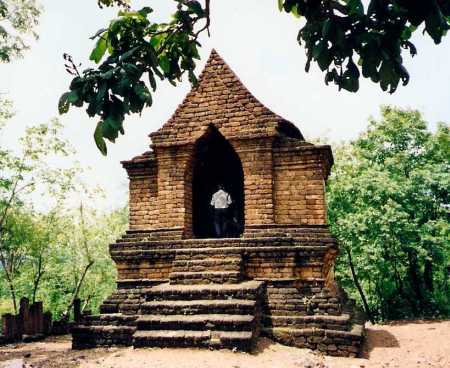
Crematory at Wat Khao Sawan Khiri |
Some of the Chedis are situated out-of-the way in the forest. There we had an encounter with the frightning red wasp which is much bigger than the european hornets and very aggressive (so we had heard). People told us it would be better to keep out of its way and in no case to strike at or to blow it away. This insect will chase its victims so long, until it catches and stings them (which is very painful).
Chiang Mai which is situated in the north of the country, is Thailand's second biggest town. It was built in 1296 by king Mengai of the Lanna-king dom, captured by the Burmese people in 1556 and recaptured in 1775.
**/You can reach Chiang Mai by comfortable fan bus
(although there are also aircon buses). Touts are
waiting for the tourists at the bus station, in order to
take them to the centre free of charge, but there's no
obligation to stay in the hotel /guesthouse they've offered.
If it does not meet one's expectations, you're free to leave
again.
Please remember that "kind" european/american people who
pretend to make your friendship, could afterwards turn out to
be heroin dealers, touts or heroin addicts.
Especially the north of Thailand is a well-known emporium for
drugs and you can easily get into trouble engaging in heroin
deals (even public notices propagate warnings, because the
penalties in Thailand are radical).
In the north we saw some of the most beautiful temples on our journey. Bright colours, roofs and ornaments decorated with gold leaf and statues of huge snakes put up beside the stairways.
In Wat Phra Singh, the most important temple of Chiang Mai, we had the opportunity to talk to young monks, who spoke very good English. They told us many things about the country, the people and their life.
One of the further sights is Doi Suthep, a temple in the west of Chiang Mai which is situated on a hill. It is very comfortable (and not expensive) to get there by Songthaew (Minibus), while the way downwards is cheaper than upwards. In order to arrive at the top of the hill about 300 steps have to be mastered, but it's worth the effort.
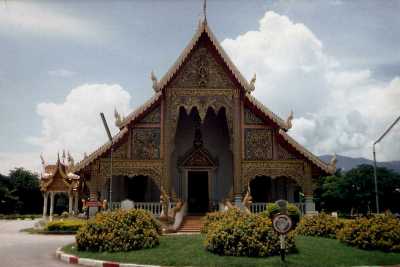
Wat Pra Singh |
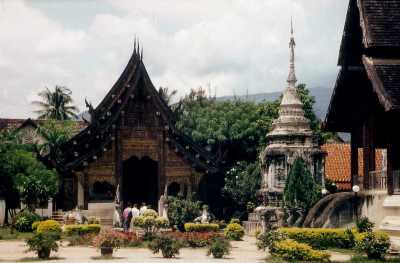
Bot at Wat Pra Singh |
Furthermore there are several Elephant Training Centres near to Chiang Mai which can be visited. Young elephants are prepared for the work in the forest. Some Centres can be reached by public bus, but there are also agencies which offer complete tours.

Suspension bridge |

Elephant training center |
 |
We didn't visit the Meo village, because we heard that the village has lost its original touch because of too much tourism. In the deep mountains of North-Thailand there are a lot of original hill tribes which live apart from civilization and use to have their own traditions, customs and habits. Unfortunately more and more of them get under the spell of exessive tourism. You can take part in trekking tours which lead to such villages - but these tours seem to be kind of mass migration and so we found it less attractive to take part in such a tour.
About 26 km from Chiang Mai away there's one of the oldest towns of Thailand - Lamphun. In the 13th century Lamphun was the capital of the Mon-kingdom Haripunchai. The most important temple of Lamphun is Wat Phratat Haripunchai with a gilt Chedi of 50 m height which was constructed in the 9th century. The entrance is free, but also smaller temples of breathtaking beauty can be visited free of charge.
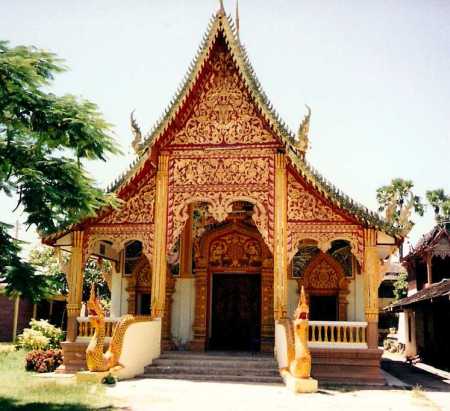
Wat Sungkaram |

Wat Kukut |
If the area is explored on foot, as we did, a bottle of water and a hat or some kind of headgear should not be forgotten. The midday heat is very debilitating. Food can be obtained almost everywhere: on the markets several dishes are offered. Especially soups, of which the firm ingredients, like noodles and vegetable are usually eaten with chop sticks. Even at the road sides there are often stands and mobile kitchens which prepare small skewers or spits with small fried eggs.

Dragon at Wat Kukut |

Golden Chedi at Wat Phra That Haripunchai |
Especially in Thailand we had the feeling that some time or other the
traveller will be accepted by the country and its life, as he
was a part of it. We have always been received very kindly.
One begins to comprehend country and people and those things which seemed
to be strange and unusual before, became obvious and self-evident.
In a country where time passes slowly and people have more time (for each
other and everything else), in a country where the poor and the rich are
living next door and where small ghost-houses or sacrificial altars are
posed in front of each building, decorated with oblations, fruits and
joss sticks.
(The oblations should attract good ghosts and make them chase bad ghosts.)
However, time and again there are certain events which make a european
mind think.
**/ There's a VIP bus, with aircon and much place in front
of the seats, to Bangkok.
It has to be reserved at the bus station. It's quite expensive,
but also very comfortable for long distances,because it drives
at night and it arrives in Bangkok at the northern bus station
in the early morning. As the buses to South Thailand start
from the southern bus station, it's the easiest way to take
a taxi. Furthermore the streets are not overfilled with
traffic at this hour.
Koh Samui is a small and meanwhile by tourism discovered island in the gulf of Siam. The night boat takes 5-6 hours and starts from Surat Thani at approx. 11.00 p.m..
After we arrived at Koh Samui we were carried on the cargo area of a Pick-up to our lodge which was situated in the south-west of the island - The Simple Life. We had already reserved our accomodation in the port of Surat Thani, but on arrival of the boat several hirer awaited the tourists.
Our lodge was situated between coconut trees right on the beach. It was a palm-roofed, wooden hovel, very simple and also very reasonable/inexensive - two chairs , a bed and a shower. Our lodgers were a gecko and a spider.
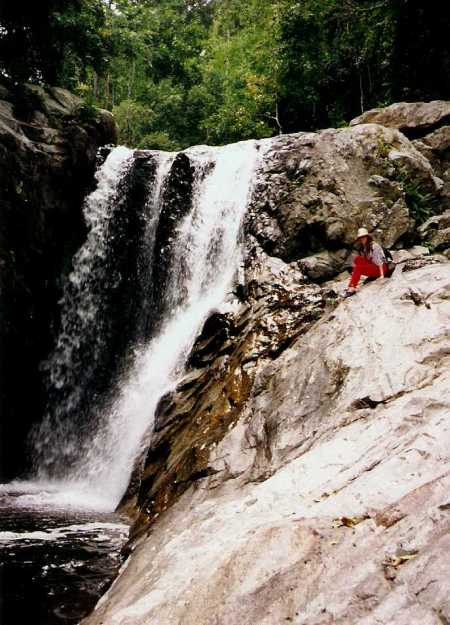
Hinlart Waterfall |
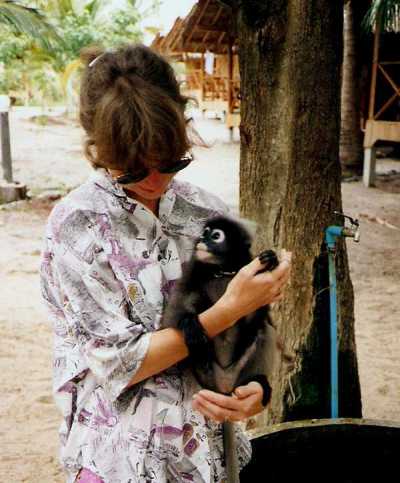
Little bad monkey |
The beach and the palm groves invited us to take a walk. Besides it's more
polite to the resident fishermen, not to wear bathing trunks or bikinies,
at least in the surroundings of their huts.
There were many things to discover: small fishing villages with reserved,
unimportunating and friendly people, large centipedes whose bite can be
very painful, leisurely, quiet water buffalos and trained apes who climbed
up the palm trees to gather the coconuts.
 Our little hut at the beach |
 Big Buddha |
During one of our walks through those palm groves we had been caught by a storm. Suddenly dozens of coconuts fell down from the trees (and we had to take care to avoid an injury) and the strong wind blew large palm leaves towards us. We had an uncanny feeling. But as fast as the storm raised as quick it had disappeared again.
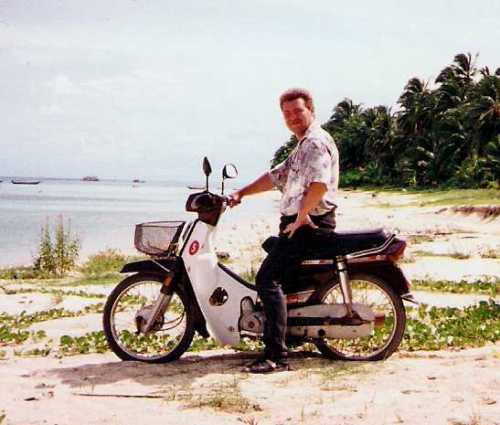 Our Honda Dream 100 |
Exploring the island by motorcycle (which could be rented in the Simple Life) was very funny, as well as our march to the Hinlard waterfall. A small path leads up to the waterfall, but the last part of the way consists of rock and small wooden steps which can be used as a bridge to cross the water (beside it's not very deep...)
**/on the way to the waterfall we saw some signes which were
set up in the forest: " Attention, take care of robbery .."
(or something of that kind)
But we only met correct and proper people in the forest.
We decided to go from Koh Samui to Phuket, an island in front of the west
coast of Thailand. We booked a complete ticket, which means by speed boat
to Surat Thani and afterwards by bus to Phuket City.
The story began when the bus started much later in Surat Thani and the
trip should take several hours more than planned...
After some kilometres the driver noticed that the bus had some kind of
problem with the engine or maybe with the radiator and so he stopped
several times to have a check. Finally we had a compulsory break of half
an hour at the roadside and the driver called some mecanics who repaired
the damage, at least partially. Soon it grew dark and the bus went further
westwards. Then, we had only 80 km to Phuket City, the driver stopped the
bus to pick up several people whose bus had a break down - They were
waiting at the roadside for help...
...our bus was quite overfilled, but according to Thai manners, all the
people and their baggage were stowed safely into the bus. But a few kilo-
metres later our bus finally broke down.
Someone had quickly organized a small Songthaew. Two additional benches
were posed onto the cargo area and about 30 people began to jam into the
Songthaew, some of them on the roof and on the footstep. The samll vehicle
was absolutely and mercilessly overfilled!!!
And we had 50 km to Phuket City...
We arrived after midnight and were dropped near the Siam Hotel (that one
we chose from a batch of hotels mentioned in the travel guide).
The hotel was already closed, but the owner of the kitchen next-door told
us that we shouldn't have to worry, certainly there would be a room for
us. Soon a gaunt man came down the stairs, caughing at each second step.
He lead us to a room at the end of the corridor. The hotel looked sleazy
and old, our room had hardly anything of furnithure inside.
But in front of the shower there was a samll coloured cloth. We both have
seen it and steped over it when we had a shower.
Just this unsignificant small cloth had disappeared when we woke up the
next morning (and we slept only for a few hours). First we thought that
someone entered the room by night: our cameras, cheques and the money
still lay on the bed, where it had been posed quite heedless at night. The
door was bolted from inside and in front of the windows there were
gratings, so it was impossible for anyone to come in. Perhaps some kind of
animal had taken the cloth. However a strange feeling turned up inside,
after all the stories of ghosts, odd phenomenons and white women, we had
been told of. We knew that Thai people believe in ghosts and we had no
explanation for that occurrence.
Suddenly we felt the strange atmosphere of that country again which acted
up on us. Indeed, this experience has concerned us very much...
The next morning we decided to explore the surroundings of Phuket City. In one of those cantinas we took a very strange breakfast, of course we like to try everything. But this meal consisted of fish, potatoes some kind of unknown and untasty vegetable or fruit and was sophisticated with (very very) hot spices. We could hardly eat it. After that fiasco we had a walk to the harbour of Phuket. In an open shipyard large, wooden ships were built by manual work. We also had a look at the fish market, where fresh fish is sold in large quantities.
We had heard about a village of sea-nomads, gipsy people who live from
the sea as a source of food and its products.
This village should be worthwile seeing and it should be near to the port.
At a junction we saw a big sign "Sea-Nomad" and thought it would be a hint
for the village. But after several kilometres of roudabout way we found
out that Sea-Nomad is a small factory which manufactures rubber boats.
But at least we had seen and learned a lot during our march: we could
watch wild monkeys at the side of the street, we saw big and gold-brown
coloured lizards, rubber plantations and crab and shell cultures at the coast.
And after all we even found the gipsy village.... a very exhausting day!
At night we slept like a log and dreamed of a further ghost story.
To visit the national park of Phang Nga we hired a guide and a longtail-boat, after having had a filling breakfast of rice and meat. The trip lasted several hours. The boat first lead through mangroves, then entered a fairyland, a wonder of nature: rock caves which could be passed by boat, wonderful rock formations which grew up from the sea and rock drawings.

At James Bond Island |
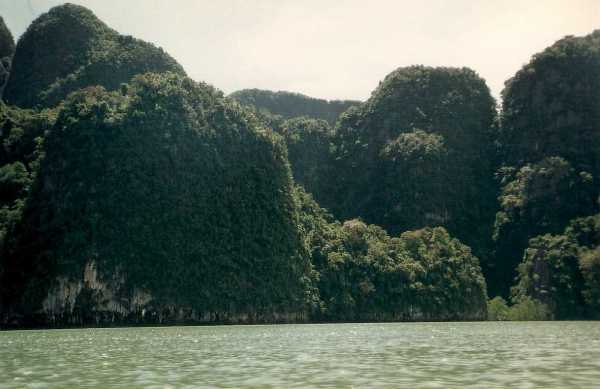
Hills at the coast |
**/ The boat trip through the region of rocky islands
was quite an adventure. We visited the samll island
of Koh Phingan which is usually called James Bond Island
since one of the James Bond films was made here.
Less exciting, so we think, was the Muslim-pile-village,
as this one had a very touristical touch. At least it was
quite difficult to discover the original village between
all the souvenir shops.
At the evening we ate Tom Yam Goong ( a sour and hot soup with shrimps) in one of those small restaurants at the main street. We also found a favourable accomodation right on the main street, the Tawi Suk Hotel. But there are a lot of small hotels which are not too expensive.
The journey to Pattalung, in the south east, was shadowed by another break down: both front tyres of the bus had deep cracks and had to be changed. The trip lasted hours again and lead over, in some parts unpaved streets. Clouds of dust entered into the unclosed bus andcovered passengers and baggage. We were quite exhausted and dirty when we arrived in Pattalung. Again we were apart of the touristic attractions. We found an accomodation in a small chinese hotel, the Universal Hotel, in front of the main street to the market. You have to enter the hotel through a pet shop.
On the market we discovered a tasty breakfast called "Rotii" , made with
dough, eggs and sweetened milk, baked on a large, hot steel plate and
folded several times.
Near the market there is a cave which was occupied by a hermit who died in
the seventies. Nowaday only some small bats are living in the cave.
Also the samll village Lam Pam, about 8 km from Pattalung in eastern direction is worth seeing. It's situated at a lagoon. We made this distance on foot, in contrary to Asian habits to take a Tuk Tuk even for short distances, and we collected many impressions.
The last stop in South Thailand was Hat Yai, a quite big town near the
malayan frontier A lot of business, much traffic, many tourists even from
Malaysia.
Our favourite snack in the evening was dried, roasted cuttlefish which
could be obtained at a small stand in the street for a few Baht.
Of course we were flattered by cats who wanted to get their part of the
meal.
From Hat Yai we took a night train to Bangkok. A very comfortable way to travel, including a meal and an occasion to sleep. It has to be reserved at the station some days in advance.
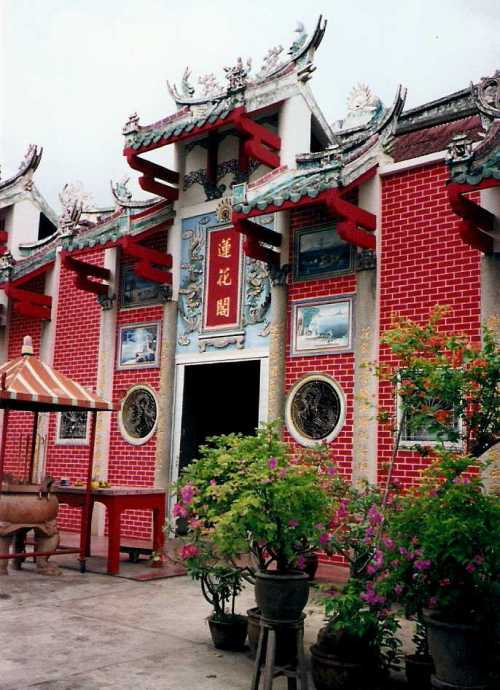
Chinese temple in Hat Yai |
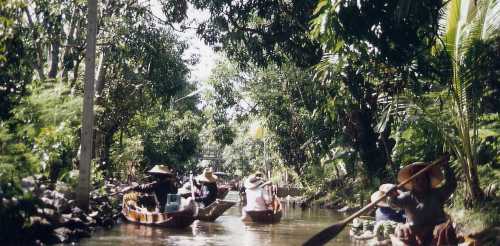
The swimming market at Damnoen Saduak |
The last days were filled with obligatory sight-seeing, e.g.like the
swimming market in Dam Noen Saduak, the royal palace of Bangkok and Golden
Mount etc...
Otherwise we let the busy atmosphere of the overcrowded capital which is
bothered with smog, take effect on us.
Bangkok, marvellous and dirty at the same time, is a big experience...!
From temples and palaces, up to big shopping centres - everything is
possible.
When we visited the National Palace, we both turned the ball which is
placed inside of the lion-statues' mouth, in front of the gate of the
entrance-hall.
That means we will return one day to Bangkok...
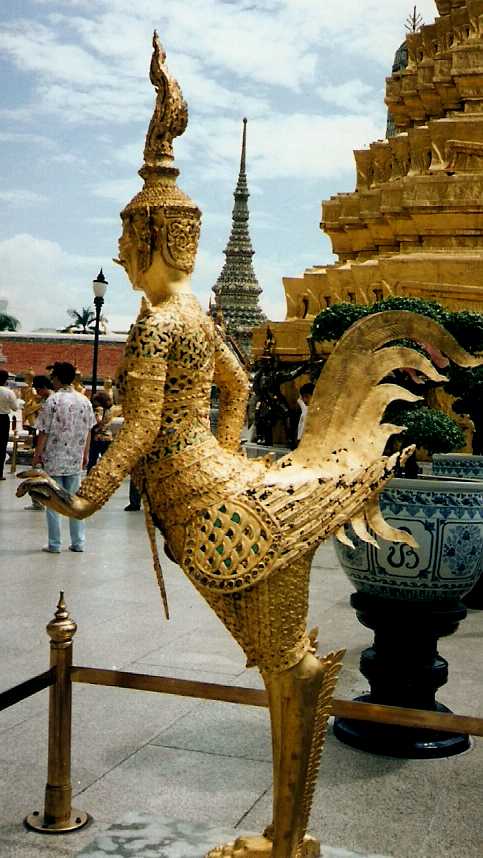
Bird man as temple guard |
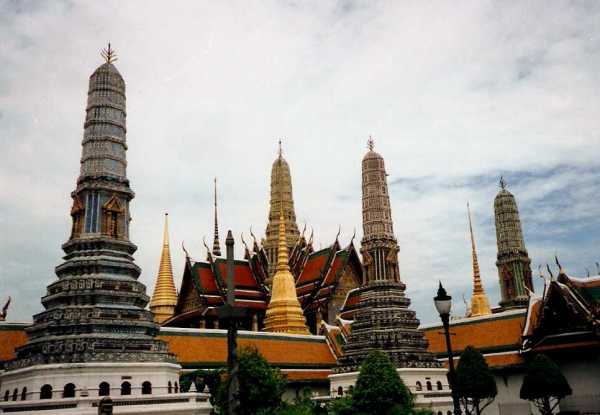
Wat Pra Kaeo |
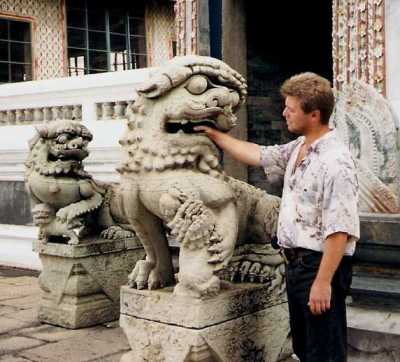
Emilio rolling the stone ball |
For sidecar fans:
 Bike with cookshop |
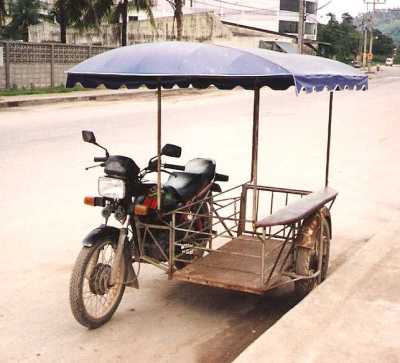 Bike prepared for transports |
© 1997/2012 Claudia Sancho Fotos: Emilio Sancho